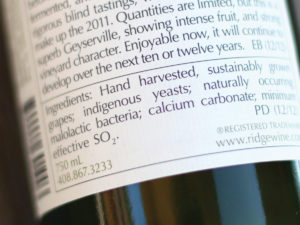SF Chronicle Credits Ridge with Natural Wine
SF Chronicle
November 2022
On November 9th, Chairman Paul Draper hosted an intimate lunch atop the Monte Bello mountain to celebrate the winery’s 60th anniversary and Esther Mobley of SF Chronicle was in attendance. In her follow-up report, Mobley points out the parallels between Ridge’s long-standing traditions of winemaking and today’s natural wine movement. Continue reading for more from Mobley about how Draper’s methodology was built and how Ridge’s dedication to these practices has withstood the test of time.
Natural Wine vs. Pre-Industrial Technique
“Draper has always referred to his philosophy as “pre-industrial winemaking.” It’s not far from the “minimal intervention” moniker that gets bandied about a lot these days. The 1960s, when he started making wine, were a time of many scientific advances in the wine industry. Newly available machinery, chemicals and processing techniques promised to simplify winemaking, to ensure consistency.
“But Draper remained convinced that the best wines he’d tasted, from both California and France, had been made in earlier decades without these new technologies. Rather than rely on the cutting-edge breakthroughs of the day, Draper taught himself to make wine by reading two 19th century manuals.

“He ended up with a regimen that would track with many of today’s natural wine producers: letting the grapes ferment with native, ambient yeast; letting malolactic fermentation, that crucial transformation that softens wines, occur on its own, again without adding bacteria; bottling the wine without sterile filtration. Draper didn’t use enzymes to kickstart the fermentation, and didn’t use additives to adjust color or tannins. He used small amounts of sulfur dioxide as a preservative.“
Transparency in Wine Labeling
While Paul Draper’s commitment to minimal intervention at Ridge started early on, this is not to say that it was not tested. In the end, it was Draper’s steadfast belief in transparency and support from the industry and consumers that led to our signature descriptions and ingredient labeling.
“The saga of Ridge’s back labels culminated in 2011, when the winery finally received permission from the federal government to list ingredients. Draper had sought to do this for years, but the government had denied his requests. Then, in 2008, he noticed that Bonny Doon winemaker Randall Grahm had gotten the green light to add an ingredient listing, so Ridge went back to the feds and finally got the OK.

“Since then, a small note on the bottom of every Ridge label has read something along these lines: “Ingredients: Hand-harvested, sustainably grown grapes; indigenous yeasts; naturally occurring malolactic bacteria; oak from barrel aging; minimum effective S02.
“It’s been more than a decade since Ridge inaugurated these ingredient labels, and the practice still hasn’t really caught on, even among younger natural-wine producers. That surprises me, and it disappoints Draper. “I really thought that I could bring other top producers along,” he said. But his sense was that other winemakers were too afraid of telling the public all their secrets.“
Mobley goes on to write:
“Yet as I reflected on Draper’s career, it struck me that few California wineries have ever achieved the sort of transparency that he modeled, and that Ridge — now under winemakers John Olney, Shauna Rosenblum and Trester Goetting and viticulturist David Gates — continues to espouse. Whether a winemaker wants to call their practices natural, pre-industrial or something else, it doesn’t mean a whole lot if it’s just a word, without an explanation. Draper always had an explanation.”

RIDGE Club Members enjoy exclusive access to library vintages. Explore ATP, Z List, and Monte Bello Collector and find the perfect club for you.
Wait!
In order to qualify for user related discounts, you must log in before proceeding with checkout. Click the button below to log in and receive these benefits, or close the window to continue.
Log In